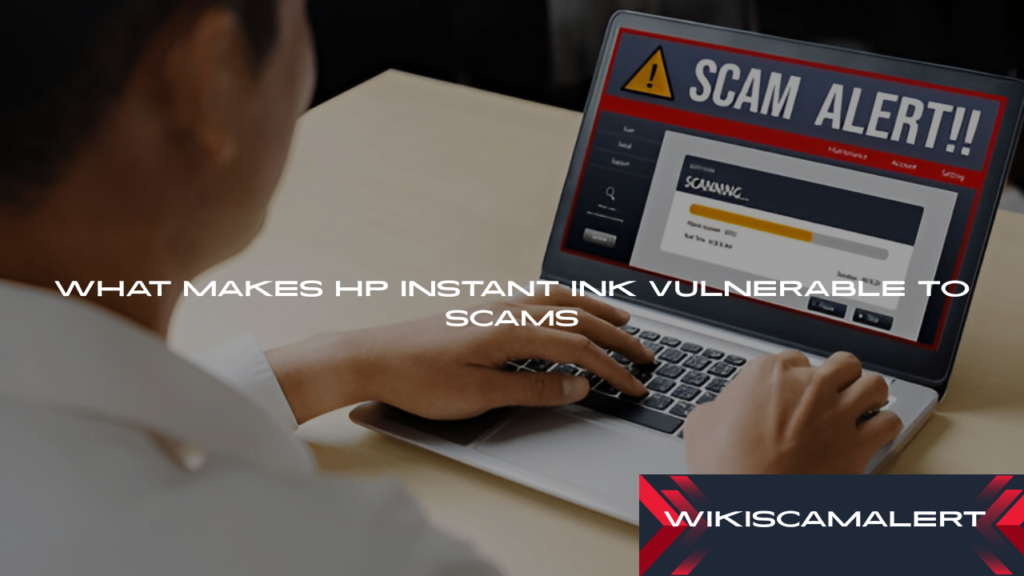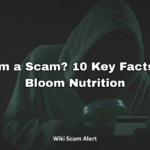The rise of subscription services has made life more convenient in many ways, with HP Instant Ink being one of the most popular options for printer users. The service promises automatic ink delivery, saving users from the hassle of buying cartridges on their own. However, as with many subscription-based services, it has also attracted its fair share of scams. The HP Instant Ink scam has left many users confused, wondering if the service itself is legitimate or if it’s just a well-disguised trap. In this article, we’ll dive deep into the world of HP Instant Ink, uncover common scam tactics associated with it, and provide tips on how to protect yourself from falling victim to fraud.
Overview of HP Instant Ink Scam
The HP Instant Ink scam is a growing issue that has affected many users of HP’s ink subscription service. HP Instant Ink is a convenient service designed to automatically deliver ink to your home whenever your printer detects that ink levels are low. While the service itself is legitimate, scammers have taken advantage of its popularity by creating fraudulent schemes that trick users into providing personal information or making unauthorized payments. These scams often come in the form of phishing emails, text messages, and fake customer support phone calls. Unfortunately, many users fall for these scams because they appear legitimate, often using the HP branding or mentioning the Instant Ink program.
HP Instant Ink is linked to a subscription model where users pay a monthly fee based on how many pages they print. Scammers prey on this subscription model, attempting to convince people to provide their financial details, personal information, or even to pay for non-existent invoices. Whether through fake websites or bogus customer service phone numbers, these scams are becoming increasingly sophisticated, targeting HP Instant Ink users across the globe.
How the HP Instant Ink Scam Works
The HP Instant Ink scam operates in various ways, but it usually involves tricking users into providing personal or financial details. Here’s how it typically works:
- Phishing Emails or Text Messages: Scammers send out messages that appear to be from HP, informing users about issues with their Instant Ink account, such as missed payments, account suspension, or unauthorized activities. These messages often include a call-to-action to “verify your account” by clicking a link, which leads to a fake website designed to steal login credentials or credit card information.
- Fake Customer Service Calls: Scammers may call you pretending to be from HP Instant Ink support, informing you that your account is about to be suspended due to an issue. They may ask you to verify your personal information or provide payment details to continue your subscription.
- Bogus Websites and Payment Requests: A more dangerous tactic involves scammers creating fake websites that look identical to HP’s official page. They may send an email or text asking you to update your payment information or confirm your subscription status. If you enter your details, the scammers steal your data.
- Fake Offers and Deals: Some scammers may even offer you “special deals” on Instant Ink plans, claiming that you can upgrade your service at a significantly discounted price. These deals often lead to phishing sites or charge you hidden fees.
Common Scams Associated with HP Instant Ink
Several common scams are associated with HP Instant Ink, and it’s essential to be aware of them to avoid falling victim. Here are some of the most frequent ones:
- Fake Subscription Fees: Scammers claim that your HP Instant Ink subscription is overdue or that you’ve been charged for an upgrade, asking for immediate payment or credit card information. These fake charges are completely fabricated, and their goal is to steal your financial details.
- Account Suspension Threats: Another common scam involves a warning that your HP Instant Ink service will be suspended unless you take immediate action. Scammers create a sense of urgency by telling you to call a fake customer service number or to click a link to “reactivate” your account.
- Phishing Links in Emails or Texts: Fraudulent emails or text messages may contain a link that leads you to a fake HP login page. Once you enter your credentials, the scammers can steal your account information and use it for malicious purposes, including identity theft.
- Bogus “Free Trial” Offers: Scammers often present fake offers for free trials of HP Instant Ink, asking you to sign up with your credit card. These offers are typically designed to trick you into entering your payment information, and you may be charged without ever receiving the service.
- Fake Refund Requests: Some fraudsters may contact you claiming that you are due for a refund for an overcharge on your HP Instant Ink subscription. They will then ask you to verify your account information or make a payment in order to receive the refund.
Red Flags of a Potential HP Instant Ink Scam
It can sometimes be difficult to tell the difference between a legitimate message from HP Instant Ink and a scam, but there are some red flags you can look out for. Recognizing these signs early on can help you avoid falling victim to fraud:
- Unsolicited Messages: Be cautious of any unexpected emails, texts, or phone calls from “HP” asking for personal or payment details. HP typically doesn’t initiate contact with users unless there is a known issue.
- Urgency or Threats: If the message you received includes a sense of urgency, such as a warning that your account will be suspended or your printer will stop working, it’s likely a scam. Scammers often use fear tactics to prompt immediate action.
- Suspicious Links or Attachments: Always be wary of links or attachments in unsolicited communications. Legitimate companies like HP won’t ask you to click on suspicious links that lead to non-HP websites.
- Unusual Phone Numbers: If you’re contacted by a phone number that isn’t recognized or seems unfamiliar (for example, with an odd area code), it could be a scam. HP’s official customer service number is widely known, and scammers will often try to impersonate these numbers.
- Poor Grammar or Spelling: Professional companies like HP take care to ensure their communications are free of errors. If an email or message is riddled with typos or awkward phrasing, it’s likely from a scammer.
- Requests for Payment Through Unconventional Methods: If you’re asked to make a payment through gift cards, wire transfers, or any method that isn’t a typical payment gateway, it’s definitely a scam. Legitimate companies won’t request payment this way.
How to Identify Fake HP Instant Ink Communications
Identifying fake HP Instant Ink communications can be tricky, but there are several telltale signs you can look for to spot fraudulent messages:
- Check the Email Address or Phone Number: Always verify that the email address or phone number is official. HP’s customer service emails come from domains like @hp.com, and the official customer service number is 1-800-474-6836. Scammers often use email addresses that look similar but have small, misleading changes (for example, hp.support@gmail.com).
- Review the Language Used: Scammers often use alarming language, such as “immediate action required” or “your account has been suspended.” Legitimate companies will generally use calm, neutral language to explain any issues.
- Look for Official Branding and Logos: If you receive an email or message that doesn’t feature HP’s official branding or logo, it’s a red flag. Fake messages will often use low-quality logos or images that are easy to spot.
- Examine the Website URL: If the message includes a link, hover over it without clicking. If the URL doesn’t begin with hp.com or a legitimate HP domain, it’s a scam. Fraudulent websites often look identical to the real thing but use different domain names (like hp-ink-support.com).
- Call HP Directly: If you’re unsure about the legitimacy of a message, contact HP’s official customer support using a verified phone number or website. Do not use any contact information provided in the suspicious communication.

What Makes HP Instant Ink Vulnerable to Scams
The HP Instant Ink scam is a growing concern for users of HP’s ink subscription service. Several factors make the system vulnerable to exploitation by scammers, leading to an increase in fraudulent activities. Understanding these vulnerabilities can help users better protect themselves from becoming victims of these scams.
- Ease of Targeting New Users: The HP Instant Ink service is popular among both new and existing customers, making it a prime target for scammers. People who are unfamiliar with the subscription model might be more likely to fall for fraudulent messages claiming to be from HP customer service, especially if they don’t fully understand how the service works.
- Automatic Billing Process: HP Instant Ink charges customers based on the pages they print each month. This automatic billing process makes it harder for users to catch discrepancies quickly, creating an opportunity for scammers to falsely claim missed payments or overcharges. Scammers may also impersonate HP representatives, claiming that the user owes a payment or is due for an upgrade.
- Lack of Awareness of Scam Methods: Many users are still unaware of the types of scams that could target them. HP Instant Ink customers might not recognize phishing emails, fake phone calls, or text scams as fraudulent. Scammers take advantage of this by mimicking official communications, such as billing inquiries or service upgrades, to trick users into revealing sensitive information.
- Use of Trusted Brand Name: The fact that scammers impersonate a well-known and trusted brand like HP makes these scams particularly effective. HP is a respected name in the technology world, and because customers trust the brand, they are less likely to question communications that look official. Scammers exploit this trust, crafting emails, texts, or phone calls that appear to be from legitimate HP representatives.
- Subscription-based Service Model: The subscription model of HP Instant Ink is another element that makes it prone to scams. Since users are automatically charged each month based on their usage, fraudsters can exploit this model by sending fake service notifications that mimic the legitimate billing alerts customers expect. These false alerts often include malicious links or requests for personal information, further increasing the likelihood of a scam.
Customer Experiences with HP Instant Ink Scams
Many customers have reported being deceived by HP Instant Ink scams, with some losing significant amounts of money or personal information. These experiences often involve common elements, such as phishing emails, fake customer support calls, and misleading offers.
- Phishing Email Encounters: A large number of users report receiving emails that appear to be from HP, informing them that there’s an issue with their Instant Ink account. These emails may mention overdue payments or ask for personal information to verify an account. In reality, these emails are attempts to steal login credentials or credit card details. Several victims have shared their experiences online, stating that they clicked on malicious links thinking they were responding to a legitimate request from HP.
- Fake Customer Support Calls: Another frequent scam involves fraudsters calling customers and posing as HP Instant Ink support agents. These scammers typically inform users that their accounts are being suspended due to issues with their payment or account status. Some customers report feeling pressured into providing credit card information or agreeing to an “immediate” resolution of the issue, only to realize later that they had been scammed.
- Unexpected Charges and Fake Refunds: Some customers have encountered fake charges or been tricked into paying for refunds that didn’t exist. After receiving a fraudulent email claiming they were due for a refund on their HP Instant Ink subscription, these customers found themselves paying more money or entering sensitive financial details into a fake website. The result was the loss of money and sometimes even further identity theft.
- Negative Impact on Trust: A common sentiment shared by users who fell victim to the HP Instant Ink scam is a decline in trust toward the brand. Many customers expressed frustration about being targeted by fraudsters using HP’s name, and some even stopped using the service entirely, feeling that HP’s security measures weren’t enough to protect them.
The Role of Phishing in HP Instant Ink Scams
Phishing is a key tactic used by scammers targeting HP Instant Ink users, and it plays a central role in many of the scams related to this service. Phishing refers to the fraudulent practice of sending emails, texts, or messages that appear to be from legitimate companies in order to steal personal information, such as login credentials, credit card numbers, or Social Security numbers.
- Phishing Emails Mimicking HP: Scammers often create fake emails that closely resemble those sent by HP. These emails typically contain official-looking logos, professional language, and urgent claims regarding the user’s account. These messages will often ask recipients to verify account details or take urgent action, such as clicking a link to “confirm” their payment method or resolve a supposed issue. The link leads to a counterfeit website where users may unknowingly enter sensitive information.
- Urgency in the Phishing Tactic: The key to phishing is creating a sense of urgency. Scammers often tell recipients that their account will be suspended or that they’ll lose access to their HP Instant Ink service unless they act immediately. This urgency is designed to encourage recipients to act quickly without thinking, leading them to click malicious links or provide private information.
- Fake Customer Support Requests: Phishing doesn’t always come in the form of emails; it can also occur via phone calls. Scammers sometimes impersonate HP customer service representatives, calling customers to address supposed issues with their Instant Ink accounts. These fraudulent callers may claim that a payment has failed, that there’s a suspicious charge, or that an upgrade is needed. They then ask for sensitive information like credit card numbers or login credentials, all in the guise of helping the customer resolve the issue.
- SMS and Text Phishing: With the increasing use of text messages for communication, SMS phishing (also known as smishing) has become a prominent tactic in HP Instant Ink scams. Fraudulent messages claiming to be from HP may ask recipients to click a link to verify their account details or receive a “special deal” on ink. These messages often contain links to fake websites designed to capture your personal details.
How Scammers Exploit HP Instant Ink’s Subscription Model
The subscription-based nature of HP Instant Ink makes it an attractive target for scammers. The way the service operates — charging users a monthly fee based on the pages they print — presents unique opportunities for fraudulent activities. Scammers exploit this system by mimicking official communications or creating fake payment-related issues.
- False Billing Inquiries: Scammers often send fake emails or text messages pretending to be billing alerts for HP Instant Ink subscriptions. These fraudulent communications will typically ask users to confirm or update payment details by clicking a link or calling a fake customer service number. This tactic is particularly effective because users expect these types of alerts and may not be suspicious when they appear to come from a trusted brand like HP.
- Subscription Upgrade Scams: Since HP Instant Ink allows users to adjust their subscription plans based on printing needs, scammers may impersonate HP and offer a “limited-time” upgrade at a discounted rate. They might claim the user’s current plan doesn’t meet their needs, convincing them to provide payment details for an upgrade. These fraudulent offers often lead to unauthorized charges or personal data theft.
- Unsolicited Charges and Account Locking: Fraudsters often send fake invoices claiming users owe money for their Instant Ink subscriptions. These bogus charges are sometimes accompanied by threats to lock or suspend accounts unless the issue is resolved immediately. In these cases, victims are encouraged to pay or provide personal information under the false belief that their accounts will be locked.
- Subscription Cancellations and Refund Requests: Scammers may also impersonate HP Instant Ink representatives and claim that users are due for a refund or that their subscriptions need to be canceled for some reason. Victims may be asked to provide financial details to process the refund or to pay additional fees for a “cancellation” that doesn’t exist.
How Scammers Get Access to Your Personal Information
Scammers use a variety of methods to gain access to your personal information when targeting HP Instant Ink users. These methods typically involve tricking users into revealing sensitive data such as login credentials, credit card information, and even Social Security numbers.
- Phishing and Spoofing Techniques: As discussed earlier, phishing and spoofing are the most common ways scammers gain access to your information. They impersonate HP through fake emails, phone calls, or websites. When users are convinced to enter personal details on these fraudulent platforms, they unknowingly hand over valuable data directly to the scammers.
- Fake Login Pages: One of the most dangerous tactics used by scammers is creating fake login pages that look identical to HP’s official website. These sites may ask for your HP Instant Ink account credentials or credit card information, but anything entered on these pages will go straight to the scammer, leaving users exposed to identity theft and unauthorized charges.
- Phone Scams and Social Engineering: Scammers often use phone calls to extract personal information from users. In these calls, they may pretend to be HP Instant Ink customer support and ask for your account details to “resolve an issue.” The fraudsters may already have partial information about the user, making their tactics more convincing. Through this social engineering method, they pressure users into giving out further personal details like credit card numbers or passwords.
- Malware and Spyware: Scammers may also attempt to install malicious software on your device through fake HP Instant Ink emails or websites. This malware can steal personal information such as saved passwords, banking details, or files from your computer. Once installed, this software can silently collect and transmit your data back to the scammers.
Fake Customer Support Numbers for HP Instant Ink
One of the most alarming tactics used by scammers targeting HP Instant Ink customers is the creation of fake customer support numbers. These fraudulent phone numbers often appear in phishing emails, text messages, or pop-up ads claiming to be from HP. The scammers pose as legitimate support agents, hoping to trick you into disclosing sensitive personal information, including your credit card details, login credentials, or other private data.
- Impersonation of Official Channels: Scammers often spoof official HP contact numbers or use similar-sounding numbers to create a false sense of legitimacy. These numbers may appear in an email or text message claiming that there’s an issue with your HP Instant Ink subscription or that you need to take immediate action. When you call the number, you’re greeted by a fraudulent agent who attempts to collect sensitive information.
- How Scammers Use Fake Numbers: The scammers often use social engineering techniques to manipulate users into giving up their personal information. They may say things like, “We need to verify your account details to restore your service,” or “We’ve noticed suspicious activity and need to confirm your payment information to prevent account suspension.” Once you provide them with your information, they can misuse it to steal your identity or commit fraud.
- The Risks of Calling Fake Support Numbers: If you call one of these fake numbers, you risk getting connected with scammers who may ask for remote access to your computer or bank account details. Once scammers gain access to your information, they could lock you out of your account, make unauthorized transactions, or install malware on your device, further compromising your security.
- How to Avoid Fake Support Numbers: Always double-check the contact information on HP’s official website or official documentation that came with your Instant Ink subscription. Never trust unsolicited phone numbers or emails, and if you suspect a communication might be fake, contact HP’s customer service through the official support channels. Make sure to report any suspicious phone numbers to HP’s fraud team to prevent others from being scammed.
HP Instant Ink Scam Alerts and Warning Signs
Recognizing the warning signs of an HP Instant Ink scam is crucial for avoiding falling victim to fraudulent schemes. Scammers are adept at creating fake emails, calls, and texts that seem legitimate at first glance, but they often contain red flags that can help users spot the scam early.
- Unsolicited Messages About Account Issues: One of the most common signs of a HP Instant Ink scam is receiving unsolicited messages claiming there’s an issue with your account. These could include emails, text messages, or phone calls warning of a payment problem, an account suspension, or an urgent need to update your payment details. Be wary of messages that appear unexpected or overly urgent.
- Suspicious Links or Attachments: A major red flag is if the message contains a link that asks you to update personal details or download an attachment. Scammers often include these links to phishing websites designed to capture your login credentials or install malicious software on your device. If the URL looks unfamiliar or doesn’t match HP’s official domain, avoid clicking on it.
- Generic Greetings: Scammers often use vague or generic greetings in their emails, such as “Dear customer” instead of addressing you by name. Legitimate companies like HP will typically use your registered name when communicating with you. If you receive a message that doesn’t include your name or specific account details, be cautious.
- Requests for Sensitive Information: A warning sign of an HP Instant Ink scam is a request for sensitive information like your password, credit card details, or Social Security number. HP would never ask you for this kind of information through unsolicited emails or calls. If anyone requests these details, especially in an unsolicited manner, it’s a scam.
- Too Good to Be True Offers: If you receive a message offering you an incredible deal or exclusive upgrade on your HP Instant Ink subscription, especially if it requires immediate action or payment, it’s likely a scam. Scammers often use irresistible offers to get users to act impulsively and provide personal information.
The Impact of Scams on Legitimate HP Instant Ink Users
The rise of HP Instant Ink scams not only impacts users who fall for fraudulent schemes but also has significant consequences for legitimate customers who rely on the service for their printing needs. Here are some of the most notable effects that scams have on genuine HP Instant Ink subscribers:
- Increased Customer Distrust: As scams involving HP Instant Ink increase, many users become more skeptical of communications from the company. Customers who have fallen victim to scams may feel less trusting of HP, even if they are not directly impacted by a scam. This decreased trust can affect HP’s reputation and drive potential customers away.
- Account Compromise and Unauthorized Charges: Scams often involve unauthorized access to user accounts, resulting in fraudulent charges. Legitimate customers who experience this can see unexpected charges or have their subscription plans altered without their consent. These unauthorized charges can lead to financial strain and the frustration of having to contact HP customer support to resolve the issue.
- Frustration and Time Loss: Victims of HP Instant Ink scams often have to spend time sorting out the mess created by fraudsters. They may need to contact HP to report the scam, file a dispute with their bank, and take steps to secure their personal data. This process is time-consuming and stressful, leaving users frustrated.
- Difficulty in Reaching Customer Support: As more people fall victim to scams, the demand for legitimate HP customer support increases. This can make it harder for legitimate customers to get timely help. Long wait times, crowded support lines, and difficulty in resolving issues further complicate the experience for users who just want to get back to printing.
- Negative Social Media Buzz: Negative experiences with HP Instant Ink scams often spill over into social media and online forums. Real customers who are affected by scams may vent their frustration online, leading to a perception that the service is unreliable. These complaints can dissuade potential customers from subscribing to HP Instant Ink and cause damage to the brand’s public image.
Is HP Instant Ink a Scam or Just Misunderstood?
While there is no denying that HP Instant Ink scams exist, it’s important to separate these fraudulent activities from the actual service itself. So, is HP Instant Ink a scam or just misunderstood? The answer lies in understanding the difference between a legitimate service and the scams that prey on unsuspecting users.
- The Legitimacy of HP Instant Ink: HP Instant Ink is a legitimate subscription service offered by HP. It is designed to provide users with an affordable and convenient way to keep their printers stocked with ink. The service uses a subscription model, where users pay based on the number of pages they print each month, rather than purchasing ink cartridges separately. There’s no inherent scam in this business model; however, scammers exploit this service to trick users into revealing personal information.
- Misunderstanding of the Service: Some users may misunderstand how the service works, leading to confusion about billing, ink delivery, or usage tracking. This confusion can sometimes create a perception that the service itself is problematic or deceptive, even though the issues arise from misunderstandings rather than the service being a scam.
- The Impact of Scammers on HP’s Reputation: Scams that target HP Instant Ink users can create a negative perception of the service itself. When victims of scams share their experiences, they may claim that the service is inherently flawed, when in fact, it is the scammers taking advantage of unsuspecting customers. This misunderstanding can tarnish HP’s reputation, even though the company itself isn’t responsible for the fraudulent actions.
- User Responsibility in Avoiding Scams: As with any subscription-based service, users must take responsibility for safeguarding their personal information. While HP does its best to protect customers, scams are an unfortunate reality of online services. It’s up to the user to remain vigilant and recognize the signs of a scam to protect themselves from fraudulent activities.
HP Instant Ink Pricing and Scams
The pricing structure of HP Instant Ink plays a role in the way scammers target users, with many fraudsters using deceptive tactics to trick customers into overpaying or revealing sensitive information.
- Affordable and Flexible Pricing: HP Instant Ink offers a variety of pricing plans based on printing needs, from light to heavy usage. For many users, the cost-effective subscription model makes sense, but scammers often exploit these pricing tiers by sending fake billing messages or claiming users are being overcharged.
- Scams Posing as Pricing Updates: Scammers may send emails or texts pretending to inform users about changes in their HP Instant Ink pricing. These fake messages could claim that a price increase is coming or that the user needs to update their billing information to avoid being charged incorrectly. Users who fall for this scam might enter payment details on fraudulent websites or share their credit card numbers with scam callers.
- Subscription Tier Exploitation: Some scammers take advantage of the subscription tiers offered by HP Instant Ink. They may impersonate customer service representatives and claim that a user’s plan is too expensive or inappropriate for their usage, offering to switch them to a different tier — one that, in reality, is a scam. Users may end up paying higher fees or providing sensitive information.
- Refund and Chargeback Scams: Scammers may also exploit the refund process related to HP Instant Ink. Victims might be tricked into thinking they are eligible for a refund and are then asked to provide personal or financial information in order to process the payment. These scams often lead to false charges or theft of sensitive data, all under the guise of refunding the customer for unused ink or unprocessed payments.
- Warning Signs of Overcharging: Users should always be on the lookout for suspiciously high charges for their HP Instant Ink subscription, particularly if they haven’t printed as much as the service suggests. If a charge seems out of place, it’s a good idea to contact HP’s official customer support to verify the amount, ensuring the charge isn’t part of a scam.
What to Do If You Receive a Scam Message About HP Instant Ink
If you receive a scam message related to your HP Instant Ink subscription, it’s essential to act quickly and cautiously to protect your personal and financial information. Scammers often create fake emails, texts, or phone calls that seem legitimate, aiming to trick you into disclosing sensitive data. Here’s a step-by-step guide on what to do if you suspect that a message is a scam:
- Do Not Click on Links or Attachments: The first thing to remember is not to click on any links or download attachments from suspicious messages. These may lead to phishing websites or install malware on your device, compromising your security. Instead, delete the message immediately.
- Verify the Source: Examine the sender’s email address or phone number carefully. Official messages from HP Instant Ink should come from a verified and official domain (e.g., @hp.com). If the address looks odd or unfamiliar, it’s likely a scam. Avoid engaging with the sender.
- Don’t Provide Personal Information: Scammers often ask for sensitive details like your credit card number, passwords, or Social Security number. Never provide any personal or financial information in response to unsolicited messages. HP will never ask you for such information in this manner.
- Contact HP Customer Support Directly: If the message claims to be from HP Instant Ink and raises concerns about your account or billing, don’t respond directly to the message. Instead, go to the official HP website and contact HP customer support using the contact details provided there. They can verify if there’s any legitimate issue with your account.
- Do Not Call the Phone Number in the Message: Scam messages may include a phone number asking you to call them urgently. Never use the phone number provided in suspicious emails or texts. Always go to HP’s official support page for the correct contact information.
- Keep Records: Take screenshots or save any suspicious emails or messages you receive. These can be helpful when reporting the scam to HP or other authorities.
Verifying the Legitimacy of HP Instant Ink Communications
Verifying the legitimacy of any communication related to HP Instant Ink is crucial to protect yourself from scams. Fraudulent messages can closely mimic genuine communications, so it’s essential to know how to confirm whether a message is legitimate.
- Check the Sender’s Email Address or Phone Number: Legitimate communications from HP will come from official domains like @hp.com. Look closely for subtle differences in the domain name or spelling. Scammers often use fake or altered domains that may seem similar but contain small discrepancies.
- Look for Personalized Information: HP will generally address you by name in emails or texts, especially if they’re communicating about your account or subscription. Generic greetings like “Dear Customer” or “Valued User” are common signs of a scam.
- Review the URL for Suspicious Links: If the message contains a link, hover over it without clicking to see the destination URL. Make sure it leads to an official HP website (e.g., hp.com). If the link looks suspicious or unfamiliar, do not click on it.
- Look for Spelling or Grammatical Errors: Scammers often rush to send fraudulent messages, and one of the signs of a scam is poor spelling or grammar. Be cautious if the message contains awkward phrasing, inconsistent punctuation, or typographical mistakes.
- Check for Red Flags of Urgency: Scammers frequently create a sense of urgency, saying things like, “Immediate action is required to prevent your account from being suspended.” Be cautious of any communication that pressures you to act quickly or make an immediate payment.
- Contact HP Directly: If you’re unsure about the legitimacy of a communication, visit the HP Instant Ink website and contact their customer support team. They can confirm whether the message you received is valid or fraudulent.
How HP is Responding to Instant Ink Scams
As the number of HP Instant Ink scams continues to rise, HP is taking proactive steps to protect its customers and combat fraudulent activity. The company has implemented several measures to help users identify and avoid scams, as well as to address any issues that arise from scam incidents.
- Improved Customer Education: HP is working to raise awareness about scams through various channels, including its website, customer support materials, and social media. The company offers guides on how to recognize scam emails, texts, and calls, ensuring users are well-informed about potential threats.
- Enhanced Security Measures: HP has implemented advanced security measures to safeguard its users from fraudulent access to their accounts. These include two-factor authentication (2FA) for account logins, regular account activity monitoring, and encryption of sensitive data to prevent unauthorized access.
- Collaboration with Authorities: HP collaborates with law enforcement and other authorities to track down scammers and bring them to justice. The company actively works with agencies to identify and shut down fraudulent operations, helping to reduce the number of scams targeting its customers.
- Scam Reporting Tools: HP provides an easy way for users to report suspected scams through their website. By submitting scam messages or reports, users help HP track patterns and address potential vulnerabilities in their communications systems.
- Dedicated Customer Support for Scam-Related Issues: If you’ve been targeted by a scam, HP offers specialized customer support to help resolve the situation. HP can assist with account recovery, fraudulent charge disputes, and guidance on securing your information after a scam incident.
- Proactive Scam Detection Alerts: HP also uses advanced algorithms and data analytics to monitor for suspicious activity on its platform. Customers who are at risk of being scammed may receive proactive alerts and tips from HP to help prevent fraud before it occurs.
Alternatives to HP Instant Ink if You’re Concerned About Scams
While HP Instant Ink is a convenient subscription service, some users may prefer alternatives if they’re concerned about the potential for scams. Fortunately, there are several other ink subscription and ink cartridge options that provide similar benefits without the same level of risk. Here are a few alternatives:
- Epson ReadyPrint: Epson’s ink subscription service is similar to HP Instant Ink in that it offers automatic ink delivery based on your printing needs. Epson promises no hidden fees and flexible subscription plans, giving you peace of mind if you’re wary of scams. The service also offers the convenience of delivering ink to your door when it’s needed.
- Canon PRINT Inkjet/SELPHY: Canon’s subscription service, available through its Canon PRINT Inkjet/SELPHY app, provides users with ink delivery based on their printing habits. Canon offers various subscription levels, and the service is designed for both home and office use.
- Third-Party Ink Subscription Services: Several third-party companies offer ink subscription plans, providing delivery of ink cartridges based on your printer’s needs. Some of these services, like Inkology or Izy Ink, allow you to choose from a variety of ink brands, offering a more flexible option compared to brand-specific services.
- Pay-As-You-Go Ink Purchases: If you’re uncomfortable with the subscription model, you can always revert to pay-as-you-go ink purchases. Many retailers offer bulk ink purchases or discounted bundles that allow you to stock up on ink for your printer. While this option lacks the convenience of automatic deliveries, it can provide more control over your ink usage and spending.
- Refillable Ink Cartridges and Printers: Some users opt for refillable ink cartridges and printers. These systems, like those offered by EcoTank (by Epson), allow you to refill your printer’s ink tank rather than purchasing new cartridges each time. This can significantly reduce costs and provide more independence from subscription services.
- Local Print Shops: If you print infrequently or have concerns about ink subscription services, local print shops may be an alternative. Many print shops allow you to print documents at affordable rates, eliminating the need for home printer subscriptions entirely.
How to Report HP Instant Ink Scams
If you’ve encountered an HP Instant Ink scam or have been targeted by fraudsters, it’s essential to report the incident to help prevent future scams and protect other customers. Here’s how you can report any fraudulent activity related to HP Instant Ink:
- Contact HP Customer Support: If you’ve received a suspicious message or have fallen victim to a scam, report it directly to HP’s customer support team. You can contact HP via their official website, where you can submit a support ticket or chat with a representative. HP can help you resolve the issue and provide guidance on protecting your account.
- Use HP’s Fraud Reporting Page: HP has a dedicated fraud reporting page where customers can submit details of any suspected scam emails, texts, or phone calls. This helps HP track fraudulent activity and take necessary actions to shut down scams.
- Report to the Federal Trade Commission (FTC): In the U.S., you can report scams to the FTC through their online platform, ReportFraud.ftc.gov. The FTC compiles complaints and works with law enforcement to investigate scams.
- Notify Your Bank or Credit Card Company: If you’ve been financially affected by a scam, contact your bank or credit card provider to report unauthorized charges. They may assist in initiating a chargeback or fraud investigation.
- File a Report with Local Authorities: Depending on your location, you can report scams to local consumer protection agencies, or your country’s equivalent of the FTC. Reporting scams to law enforcement helps build a case against perpetrators and helps prevent others from being scammed.
- Alert Other Victims: If you’ve been affected by an HP Instant Ink scam, consider sharing your experience on online forums, social media, or consumer advocacy websites to help warn others. By spreading awareness, you can help reduce the likelihood of others falling victim to similar scams.
What Is HP Instant Ink?
HP Instant Ink is a subscription-based service that automatically delivers ink to your doorstep before your printer runs out. It’s an innovative solution for consumers who don’t want to worry about running out of ink or finding the right cartridges. By signing up for this service, you pay a monthly fee based on the number of pages you print.
Why It’s Gaining Attention (For the Wrong Reasons)
While HP Instant Ink offers convenience, its name has also become synonymous with fraudulent activities. Scammers have started posing as HP representatives, contacting users through phone calls, emails, or even text messages, claiming they need to update their account details or pay overdue fees. This has led to confusion, with many consumers questioning whether HP Instant Ink is a scam.
Understanding the HP Instant Ink Scam
Real Service or Just a Clever Trap?
The HP Instant Ink scam plays on the legitimacy of the subscription service itself. Scammers use similar-looking emails or text messages that appear to come from HP, often asking users to update their payment information. In reality, they’re looking to steal your personal details.
Is HP Instant Ink a Scam or Misunderstood Subscription Model?
HP Instant Ink is not a scam—its subscription service works as advertised. However, the scams associated with it are based on phishing tactics. If you ever receive a message claiming to be from HP but aren’t sure, it’s crucial to verify the source first.
The Question Everyone Asks: “Is HP Instant Ink a Scam?”
No, HP Instant Ink itself is not a scam. However, there are HP Instant Ink scam texts circulating. These deceptive messages often promise great deals or threaten account suspension unless you act immediately.
How the HP Instant Ink Scam Works
The 855-785-2777CA Incident Explained
A common scam involves messages from the number 855-785-2777CA, claiming that your HP Instant Ink subscription needs urgent updating. This is a known scam number that targets consumers, attempting to trick them into providing sensitive personal information.
Phishing Emails and Fake Subscription Links
Phishing is the most common method used in these scams. Fraudulent emails may contain links that redirect you to a fake HP login page, where you’re asked to input your personal details, including payment information. Always check the sender’s email address and website URL before clicking on any link.
Common Red Flags in the Scam
Be wary of urgent messages or unfamiliar phone numbers. If an email or text contains grammatical errors or generic greetings (like “Dear Customer”), it’s likely a scam. Legitimate communications from HP should be personalized.
What People Are Saying Online
HP Instant Ink Scam Reddit Discussions
Reddit threads are filled with user experiences, some positive and others cautionary. Many users report receiving scam messages that look like official HP communications, leading to confusion and frustration. Reddit serves as a great resource for finding real user experiences with the HP Instant Ink scam.
Forums and Real-User Horror Stories
On various online forums, users share their stories of falling for HP Instant Ink scams. From unexpected charges to locked printers, these real-life accounts highlight the importance of being cautious when dealing with unsolicited communications.
Conclusion
While HP Instant Ink is a legitimate service designed to make ink management easier and more affordable, it has unfortunately been tainted by scams. These fraudulent activities often involve phishing attempts or fake customer support numbers, leading unsuspecting users into dangerous situations. The key takeaway is that HP Instant Ink itself is not a scam, but it’s essential to stay vigilant when dealing with unsolicited messages, calls, or offers that seem too good to be true. Always verify the source of any communication, and take immediate action if you suspect fraud. With the right precautions, you can enjoy the benefits of HP Instant Ink without falling victim to the growing number of scams associated with it.
FAQs:
1. Is HP Instant Ink a legitimate service or a scam?
HP Instant Ink is a legitimate subscription service that automatically delivers ink to your door when your printer is running low.
2. How do I cancel HP Instant Ink and stop being charged?
To cancel your HP Instant Ink subscription, log into your HP account, go to the “Subscription” section, and follow the cancellation process.
3. What does the number 855-785-2777CA mean in this context?
The number 855-785-2777CA is often associated with scam attempts related to HP Instant Ink. Fraudsters may use this number to trick people into providing personal or payment information, so it’s best to avoid engaging with it.
4. Can HP really disable my printer if I cancel?
HP has been known to restrict certain features of printers tied to their Instant Ink subscriptions, but this is generally part of the subscription agreement.
5. Are there safe alternatives to HP Instant Ink?
Yes! There are several third-party ink services and pay-as-you-go options that offer flexibility without locking you into a subscription plan.










